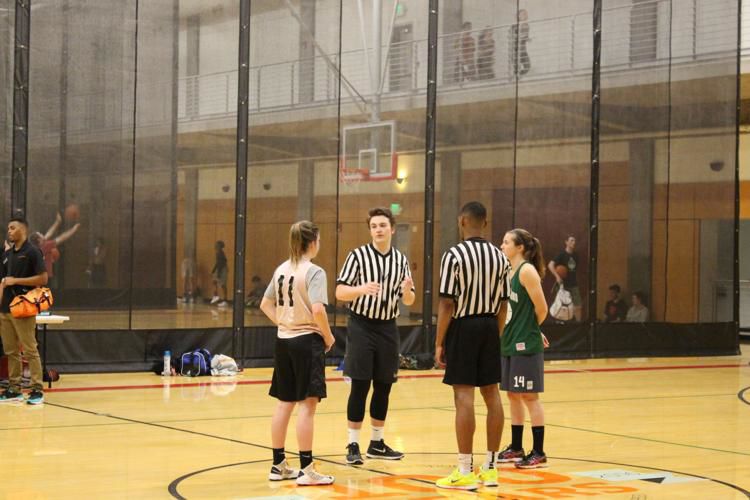Intramural female participation hits five-year low
January 14, 2019
Almost every inch of the courts at Dixon Recreation Center was covered by basketball shoe-clad feet, with 117 students waiting for the 3v3 co-rec basketball tournament to begin. Out of these 117 players, however, only a handful stood out—the sole nine female participants.
The fall 2018 tournament reflects an overall trend of shrinking female participation in Oregon State University intramural sports. OSU’s Department of Recreational Sports, however, is working to promote female participation.
“We’re always looking for ways to improve how Rec Sports as a department is serving the female population,” said Joe Schaffer, assistant director of Sport Programs.
For at least the past five years, females have consisted of roughly 25 percent of total OSU total intramural sport participation, according to data gathered by the DRS.
During the 2017-18 academic year, intramurals saw 2527 total females participate and 8043 total males. These numbers also mark a decrease in overall attendance, with female participation shrinking nearly 14.5 percent and male participation shrinking 10.8 percent from the previous year.
“We’ve always sat at around 25 percent of our participant being female,” Schaffer said. “I’d say that’s about on par with other universities when it comes to intramural sports.”
The low rates of female intramural engagement may be influenced by the limited opportunities women were given in the past, according to graduate assistant of Sport Programs, Megan Guilfoyle.
“I think historically, since there has been a low turnout in women’s leagues, it has encouraged us to open more opportunities for men’s teams to fill those open timeslots,” Guilfoyle said. “Since that strategy has worked, women’s leagues are now limited to few time slots, and unfortunately they might not be available to play during those times despite those times being popular in the past.”
Some female intramural participants have felt the present repercussions of historical limitations on female participation. Ellie VanDevelder, a third-year studying education and political science, has previously participated in both female and co-rec leagues. As one of the nine women who played in the 2018 3v3 basketball tournament, she found it discouraging to see the lack of female teams.
“I felt like I didn’t belong,” VanDevelder said. “There were so few of us (females) in a male-dominated space that I felt like I really faded into the background.”
VanDevelder said she would have felt much more comfortable if more females had participated in the tournament.
“I think there would’ve been a bigger group confidence for the females, like a sense of belonging,” VanDevelder said. “It also would have demanded more space in the room and respect from our male counterparts, showing that basketball is just as much for girls as it is for guys.
VanDevelder is not the only one to recognize the low number of females in intramural sports. Schaffer and the DRS are aware of the gender discrepancy, noting that other universities are facing the same difference.
The DRS has been working to promote more equitable participation, specifically through marketing material and hiring processes.
“I don’t know if we’ll ever get it to 50/50, but we’re always looking for ways to do that,” Schaffer said. “When we add a new sport, we’re definitely looking for sports where we’ll see men and women participate.”
Additionally, Schaffer and his team try to promote participation from both genders indirectly through their selection of promotion materials.
“We are very conscious of what our marketing material looks like, making sure that there’s a balance between genders in that material so everyone can see themselves in our sports,” Schaffer said.
Internal hiring processes can also impact participation, Schaffer said. Females employees who supervise field and court intramural play outnumber male employees.
“Those are two ways that we are looking for females to see themselves in our program, either through employment or through marketing material that goes out,” Schaffer said.
The Department of Rec Sports also made a significant change last year to increase equity in play between the genders.
Up until the fall of 2017, some intramural co-rec teams employed different rules for men and women. For example, women’s baskets scored would be worth twice that of a men’s basket. However, the DRS did away with the rule differences at the beginning of the 2017 academic year after receiving negative feedback from female players, according to Guilfoyle.
“We have gotten rid of certain rules that limited game flow because those rules were meant to encourage men to involve women in play and vice versa, however we learned that was not a reality we needed to prevent,” Guilfoyle said. We have moved away from those stipulations.’
All co-rec leagues now have the same rulebook between the genders, with the exception of the “plus-one” gender requirement concerning the number of participants on a court or field. If a team has five players, for example, it needs to be split two of one gender and three of the other.
The DRS has received a positive reaction since the change, Guilfoyle said.
“Students have really enjoyed being able to have freedom in softball pitching line-ups or volleyball rallies or flag football plays, just to name a few examples,” Guilfoyle said. “In addition, I think women feel a sense of empowerment that they don’t need any extra boost in order to be as competitive as the men.”
Guilfoyle hopes for increased female participation in upcoming sports, noting that volleyball is the only sport that is consistently comparable in numbers between men and women.
“I would love to see this extend to more sports,” Guilfoyle said.
Winter term registration opens Monday, Jan. 14. This year, all registration takes place online and can be found on the Department of Recreational Sports’ webpage. The registration deadline is Jan. 22.










































































































